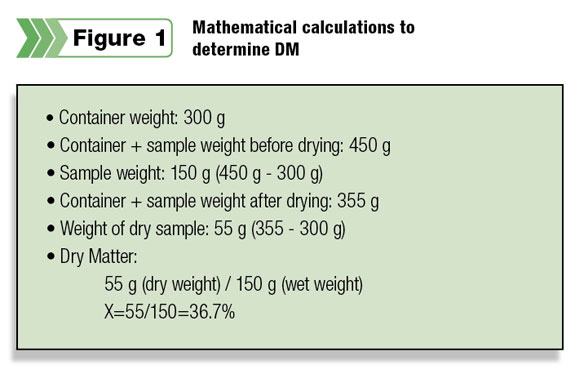Therefore, we should routinely evaluate feedstuff’s DM, especially wet products like silages. Results from a recent feeding management survey indicate that dairy producers (52.3 percent) evaluate corn silage DM at least once a month but only 8.3 percent of dairies determined DM weekly or more often.
Most dairies (86.6 percent) delegated DM determination to an outside consultant.
The frequency of forage DM determination in California dairies may be inadequate. The University of Wisconsin recommends one, two, three, four, six or seven DM determinations per month for dairies with 50, 100, 200, 400, 800 or 1,600 cows, respectively.
When developing a sampling plan, we should also consider the weather conditions. After a rainfall event of 20 mm (0.8 of an inch), two ensiled forages with 30 percent and 50 percent of DM became wetter, 25.9 percent and 43.1 percent of DM, respectively.
In California, some dairies have reported an increase in the incidence of displaced abomasums during the rainy season. This could be explained by failing to adjust the loading sheets for wetter forages, resulting in rations short on forage fiber.
Following are descriptions of the equipment and methods that can be utilized to determine DM:
• Air-circulating oven: This is the standard method but is expensive and requires 24 to 48 hours of drying.
• Koster tester: It is an electrical device that pushes hot air through a grid in which we place the feed. It has a timer which allows the operator to perform other tasks while the feed dries. The results are available in about two hours. The equipment cost is around $340.
• Microwave: It has the advantage of being fast (20 to 30 minutes). However, it requires the presence of an operator.
To prevent the sample from overheating and burning, the operator should turn the microwave on and off every three to five minutes and a glass of water must be placed inside. Never dry forages in a microwave used for human food because pathogenic microorganisms are found in silages.
• Vortex dryer: This device is fast, easy to use and inexpensive. It is made with a hair drier attached to a vortex.
• Food dehydrator: This method is easy but requires two to eight hours.
• Near-infrared (NIR): The NIR boxes are available for use on dairies. They are quick (one to two minutes) and easy to use but very expensive.
There is one company that offers a NIR unit attached to the skid loader bucket. The NIR unit combined with feeding management software, and a mixer wagon scale, allows the feeder to receive real-time information on the correct ingredient weights that he must load.
They also offer portable NIR units. Another company markets a NIR unit that can be placed in the trunk of the chopper or on a table top.
When placed on the chopper, harvesters can use the real-time DM information to adjust the cutting settings. When placed on a table top, the NIR unit can be used at the dairy to determine the DM of the feed.
 It is essential to have one of the devices mentioned above and a calibrated scale to accurately determine DM on the farm.
It is essential to have one of the devices mentioned above and a calibrated scale to accurately determine DM on the farm.
The mathematical calculations to determine the DM are simple, as shown in the example (see Figure 1).
Before using the new DM results to adjust the ingredient load sheets, we should consider the following:
• If the most recent results indicate that DM has changed three points or more, it is recommended to repeat the DM measurement and evaluate if the appearance of the ensiled crop matches the results.
• If the most recent results indicate that DM has changed one point or more and the same result is found consistently (± one point for three consecutive days), the ration should be adjusted.
Researchers recommend weighted averages of the three most recent DM results. So the most current DM result will be assigned a weight of 50 percent, the second-most current result of 30 percent and the third- most current 20 percent.
However, when applying the weighted average we should consider possible events (such as rain) that make it more suitable to use that day’s results rather than the weighted average.
Frequent evaluation of silage DM is critical to ensure cows are eating the balanced ration the nutritionist has formulated. FG
References omitted due to space but are available upon request. Click here to email an editor.
—Excerpts from University of California Agriculture and Natural Resources California Dairy Newsletter, Vol. 3, No. 4











